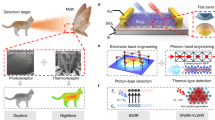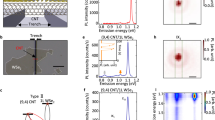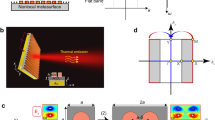Abstract
A MAJOR portion of infra-red spectroscopy to-day is directed toward the determination of characteristic vibrational frequencies of polyatomic molecules. In almost all cases the information is limited because the broad bands overlap. Cooling the sample to low temperatures offers the possibility that the natural width of each band is reduced sufficiently to resolve individual vibrational frequencies. The extent of the improvement has recently been the subject of a considerable amount of controversy. Walsh and Willis1 and we2 have pointed out that, in general, quantized rotation does not occur in condensed phases, so that one cannot agree with Avery, Morrison and Ellis3, who stated that narrowing would obey the very strong law, ∼ T½, characteristic of rotational structure. However, we cannot agree with Walsh and Willis that narrowing can only occur through a change of state. On the contrary, on very general grounds2,4, some narrowing would be expected from depopulation of the Debye acoustic waves, which are coupled with the molecular vibrations to give width to the bands.
This is a preview of subscription content, access via your institution
Access options
Subscribe to this journal
Receive 51 print issues and online access
$199.00 per year
only $3.90 per issue
Buy this article
- Purchase on SpringerLink
- Instant access to full article PDF
Prices may be subject to local taxes which are calculated during checkout
Similar content being viewed by others
References
Walsh, A., and Willis, J. B., J. Chem. Phys., 18, 552 (1950).
King, G. W., Hainer, R. M., and McMahon, H. O., J. App. Phys., 20, 559 (1949).
Avery, W. H., and Ellis, C. F., J. Chem. Phys., 10, 10 (1942). Avery, W. H., and Morrison, J. R., J. App. Phys., 18, 960 (1947).
Hornig, D. F., J. Chem. Phys., 16, 1063 (1948).
Abstracts of the 115th Meeting of the Amer. Chem. Soc., 43 (1949).
Hainer, R. M., and King, G. W., Phys. Rev., 70, 473 (1949).
A detailed account of this treatment is to be published elsewhere.
The sample was prepared by a modification of the technique described by McMahon, H. O., Hainer, R. M., and King, G. W., J. Opt. Soc. Amer., 39, 786 (1949).
Author information
Authors and Affiliations
Rights and permissions
About this article
Cite this article
HAINER, R., KING, G. Effect of Low Temperatures on Infra-Red Spectra. Nature 166, 1029 (1950). https://doi.org/10.1038/1661029a0
Issue date:
DOI: https://doi.org/10.1038/1661029a0
This article is cited by
-
Infrared and Raman spectra of 2,4-dimethylaniline
Proceedings / Indian Academy of Sciences (1986)



